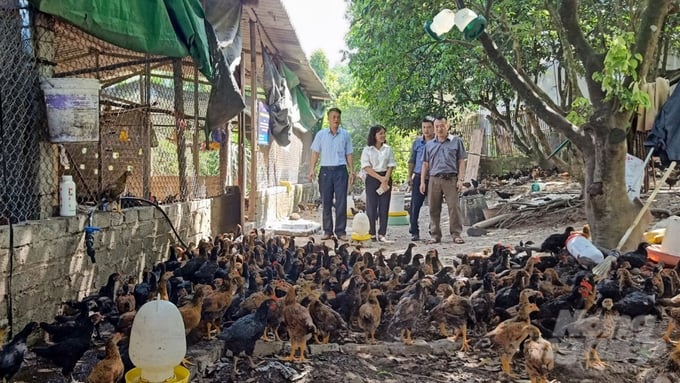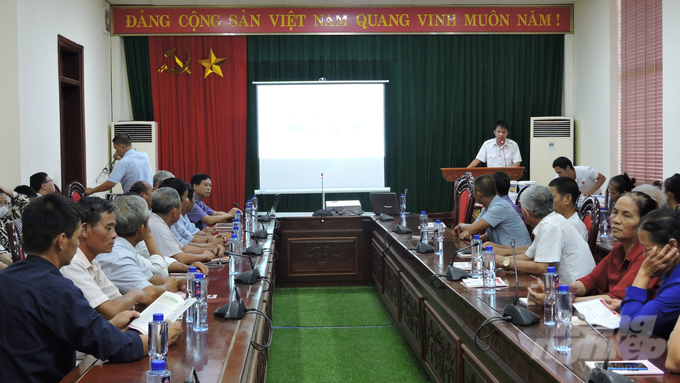November 26, 2025 | 00:15 GMT +7
November 26, 2025 | 00:15 GMT +7
Hotline: 0913.378.918
November 26, 2025 | 00:15 GMT +7
Hotline: 0913.378.918

Bac Giang places special emphasis on hillside chicken farming to ensure disease safety. Photo: Toan Nguyen.
As a province with a vast livestock sector, disease prevention and control for livestock and aquatic animals have been of utmost concern to the provincial People's Committee and the Department of Agriculture and Rural Development in Bac Giang. It is crucial to recognize the outbreak of any disease in livestock which can lead to wide transmission and significant economic losses that are challenging to resolve.
Since the beginning of 2023, the Sub-department of Livestock and Veterinary of Bac Giang has actively collaborated with districts and cities within the province to implement disease prevention and control plans for cattle, poultry, and aquaculture.
The plans include measures to combat African swine fever in Bac Giang province from 2021 to 2025, control lumpy skin disease in cattle and buffalo from 2022 to 2025, and prevention of rabies in animals from 2022 to 2030.
To ensure effective disease prevention, three inspection teams have been established to oversee livestock production and disease control, with responsibilities to examine and guide disease prevention efforts in localities across the province.
Furthermore, they are also focused on prevention, inspection, and addressing violations related to the illegal transportation and trade of livestock, poultry, and their products without proper veterinary inspection and any other related violations.
Mr. Luong Duc Kien, Deputy Director of Sub-department of Livestock Production and Animal Health in Bac Giang, affirmed that since the beginning of 2023 until now, there have been no occurrences of dangerous diseases such as foot-and-mouth disease, blue ear disease, avian influenza, lumpy skin disease, or African swine fever in Bac Giang province.
Other diseases like avian septicemia, Newcastle disease, duck plague, porcine septicemia, and swine erysipelas have sporadically happened in some localities within the province but were promptly controlled and treated, preventing them from becoming outbreaks.

From the beginning of 2023 up to now, in Bac Giang province, there have been no large outbreaks in livestock herds. Photo: Trung Quan.
During the first 6 months of the year, the Sub-department of Livestock and Veterinary of Bac Giang province has collaborated with localities within the province to raise awareness and guide the local people in developing livestock according to the regional planning, ensuring disease safety and biological safety in livestock farming. They have strengthened the care and nurturing of animals, regularly implementing hygiene, detoxification, and disinfection measures in the livestock environment. Additionally, they have administered complete vaccinations for necessary diseases to prevent illnesses in animals.
Additionally, they have enhanced the management and close monitoring of disease outbreaks in livestock, particularly for highly contagious diseases such as African swine fever, foot-and-mouth disease, avian influenza, etc., to promptly detect and handle any cases of disease in animals, preventing outbreaks and minimizing the spread of diseases.

A training course on prevention and control of African swine fever. Photo: Toan Nguyen.
Currently, in the entire province of Bac Giang, there are over 30,600 buffalo, nearly 110,000 cattle, almost 900,000 pigs, and approximately 20 million poultry. The total estimated meat production of various types is nearly 150,000 tons.
In 2023, the Sub-department of the Livestock and Veterinary of Bac Giang province has conducted five training sessions funded by the provincial budget for disease prevention and control, focusing on African swine fever. The target audience for these sessions included pig farmers and veterinary officers in districts with significant pig herds, such as Hiep Hoa, Lang Giang, Viet Yen, Tan Yen, and Yen The. These are the localities known for their livestock-friendly environment and large-scale pig farming in Bac Giang province.
Mr. Nguyen Huy Khanh, Deputy Head of the Technical Division at the Sub-department of Livestock and Veterinary, shared that by August 4th, the final training session was organized in Lang Giang district, successfully completing the training program on African swine fever prevention and control throughout the province.
From the beginning of the year until now, livestock farmers in Bac Giang province have proactively implemented vaccinations with a high coverage rate for various vaccines on their livestock. These vaccinations include 10,680 doses of foot-and-mouth disease vaccine for cattle and buffalo, 15,600 doses of swine fever vaccine, 35,800 doses of swine foot-and-mouth disease vaccine, over 32,000 doses of Newcastle disease vaccine, 165,000 doses of duck plague vaccine, and 600,000 doses of avian influenza vaccine…
Translated by Nguyen Hai Long
/2025/11/24/3536-2-112800_176.jpg)
(VAN) Dong Nai now has tens of thousands of hectares of forests certified for sustainable management, and this area will continue to be expanded in the coming period.

(VAN) Vinh Ha hamlet (Dai Xuyen commune, Hanoi) is shifting away from small-scale farming as households adopt bioscurity into their breeder chicken models.

(VAN) Heavy rains make aquatic species more vulnerable to disease. Proactive water management and high-tech systems help farmers prevent outbreaks and protect yields.

(VAN) Greenhouses are shifting production mindsets in Binh Lu commune, enabling farmers to ‘weather the sun and rain’ and secure stable vegetable harvests throughout the year.

(VAN) Green transition is crucial for the Mekong Delta amid climate change and stricter standards, offering a path toward sustainability.

(VAN) Dong Thap promotes agricultural restructuring, forms large specialized farming zones, raises the value of agricultural products and develops toward ecological and high-tech directions.
/2025/11/22/4018-4-213342_747.jpg)
(VAN) The Mekong Delta Agricultural Experts Club has attracted 143 experts and researchers to participate in providing consultancy and contributing initiatives to the development of one million hectares of high-quality rice.